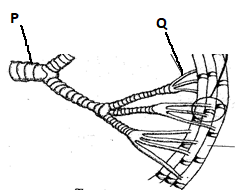Question
The diagram below represents part of a gaseous system in a grasshopper.

(a) Name the structures labeled P and Q
P-
Q-
(b) State the function of the structure labeled P.
(c) Describe the path taken by carbon (IV) oxide from the tissues of the insect the atmosphere.
(d) How is the structure labeled Q adapted to its functions.

(a) Name the structures labeled P and Q
P-
Q-
(b) State the function of the structure labeled P.
(c) Describe the path taken by carbon (IV) oxide from the tissues of the insect the atmosphere.
(d) How is the structure labeled Q adapted to its functions.
Answer
(a) P - rings of chitin/ spiral bands
Q - tracheoles
(b) Circular rings keep the trachea open when pressure is exerted inside the lumen is low
(c) Carbon (IV) oxide is of high concentration in the muscle tissue therefore it diffuses from the tissues into the tracheoles and moves to the trachea and out through the spiracles into the atmosphere.
(d) - The walls are thin and lack chitin for rapid diffusion of gases
- Walls are moist to dissolve gases
- They are highly branched to increase the surface area for gaseous exchange
Q - tracheoles
(b) Circular rings keep the trachea open when pressure is exerted inside the lumen is low
(c) Carbon (IV) oxide is of high concentration in the muscle tissue therefore it diffuses from the tissues into the tracheoles and moves to the trachea and out through the spiracles into the atmosphere.
(d) - The walls are thin and lack chitin for rapid diffusion of gases
- Walls are moist to dissolve gases
- They are highly branched to increase the surface area for gaseous exchange

